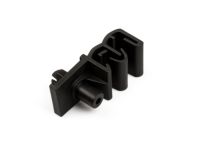During inspection, when the vehicle is raised on jackstands, thoroughly examine the rubber hoses connecting the steel brake lines to the front and rear brake assemblies for any signs of damage, such as cracks, chafing, leaks, blisters, or other issues. Utilize a light and mirror for a comprehensive check. If any hose shows the mentioned conditions, it should be replaced immediately. To replace a flexible hose, clean the hose fittings, then disconnect the metal brake line from the hose fitting using a flare-nut wrench, being cautious not to damage the frame bracket or line. If the fitting is corroded, apply penetrating oil and allow it to soak before retrying. Remove the brake hose from the bracket, and if it's a rear brake hose on a drum-brake model, use a flare-nut wrench to loosen the line fitting at the wheel cylinder and remove the hose. For hoses attached to the caliper with a banjo bolt, unscrew the bolt and remove the hose, replacing the sealing washers on both sides of the fitting. Attach the new brake hose to the caliper or wheel cylinder, ensuring to use new sealing washers and tightening the banjo bolt to the specified torque. Insert the other end of the new hose through the bracket or attach the fitting/bracket to the vehicle, ensuring the hose isn't kinked or twisted, then fit the metal line to the hose (or hose fitting) and tighten the hose bracket and brake tube fitting nut securely. Check to ensure the hose doesn't make contact with suspension or steering components during vehicle operation. After installation, check the master cylinder fluid level, add fluid if needed, bleed the brakes, and thoroughly test brake operation before normal use. When replacing brake lines, use appropriate steel brake lines, not copper tubing, and ensure correct parts are used. Prefabricated brake lines with flared tube ends and fittings can be used, and if bending a line is necessary, use a tubing bender to prevent kinks. During installation, support the new line securely in brackets and provide sufficient clearance between moving or hot components. Tighten fittings securely. After installation, check the master cylinder fluid level, bleed the brakes, and thoroughly test brake operation before resuming normal use.
Posted by MoparPartsGiant Specialist 









